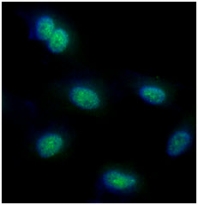ARG57049
anti-FUBP1 antibody [14F5]
anti-FUBP1 antibody [14F5] for ICC/IF,Western blot and Human
Overview
| Product Description | Mouse Monoclonal antibody [14F5] recognizes FUBP1 |
|---|---|
| Tested Reactivity | Hu |
| Tested Application | ICC/IF, WB |
| Host | Mouse |
| Clonality | Monoclonal |
| Clone | 14F5 |
| Isotype | IgG2b, kappa |
| Target Name | FUBP1 |
| Antigen Species | Human |
| Immunogen | Recombinant fragment around aa. 279-448 of Human FUBP1. |
| Conjugation | Un-conjugated |
| Alternate Names | FBP; Far upstream element-binding protein 1; FUSE-binding protein 1; hDH V; FUBP; DNA helicase V |
Application Instructions
| Application Suggestion |
|
||||||
|---|---|---|---|---|---|---|---|
| Application Note | * The dilutions indicate recommended starting dilutions and the optimal dilutions or concentrations should be determined by the scientist. |
Properties
| Form | Liquid |
|---|---|
| Purification | Purification with Protein A. |
| Buffer | PBS (pH 7.4), 0.02% Sodium azide and 10% Glycerol. |
| Preservative | 0.02% Sodium azide |
| Stabilizer | 10% Glycerol |
| Concentration | 1 mg/ml |
| Storage Instruction | For continuous use, store undiluted antibody at 2-8°C for up to a week. For long-term storage, aliquot and store at -20°C. Storage in frost free freezers is not recommended. Avoid repeated freeze/thaw cycles. Suggest spin the vial prior to opening. The antibody solution should be gently mixed before use. |
| Note | For laboratory research only, not for drug, diagnostic or other use. |
Bioinformation
| Database Links |
Swiss-port # Q96AE4 Human Far upstream element-binding protein 1 |
|---|---|
| Gene Symbol | FUBP1 |
| Gene Full Name | far upstream element (FUSE) binding protein 1 |
| Background | The protein encoded by this gene is a single stranded DNA-binding protein that binds to multiple DNA elements, including the far upstream element (FUSE) located upstream of c-myc. Binding to FUSE occurs on the non-coding strand, and is important to the regulation of c-myc in undifferentiated cells. This protein contains three domains, an amphipathic helix N-terminal domain, a DNA-binding central domain, and a C-terminal transactivation domain that contains three tyrosine-rich motifs. The N-terminal domain is thought to repress the activity of the C-terminal domain. This protein is also thought to bind RNA, and contains 3'-5' helicase activity with in vitro activity on both DNA-DNA and RNA-RNA duplexes. Aberrant expression of this gene has been found in malignant tissues, and this gene is important to neural system and lung development. Binding of this protein to viral RNA is thought to play a role in several viral diseases, including hepatitis C and hand, foot and mouth disease. Alternative splicing results in multiple transcript variants. [provided by RefSeq, Dec 2014] |
| Function | Regulates MYC expression by binding to a single-stranded far-upstream element (FUSE) upstream of the MYC promoter. May act both as activator and repressor of transcription. [UniProt] |
| Calculated MW | 68 kDa |
| PTM | Ubiquitinated. This targets the protein for proteasome-mediated degradation. |
Images (2) Click the Picture to Zoom In
-
ARG57049 anti-FUBP1 antibody [14F5] ICC/IF image
Immunoflorescense: HeLa cell line stained with ARG57049 anti-FUBP1 antibody [14F5] at 1:100 (Green).
DAPI (Blue) for nucleus staining.
-
ARG57049 anti-FUBP1 antibody [14F5] WB image
Western blot: 40 µg of 1) HeLa cell lysate, 2) HepG2 cell lysate, 3) Jurkat cell lysate stained with ARG57049 anti-FUBP1 antibody [14F5] at 1:1000.







